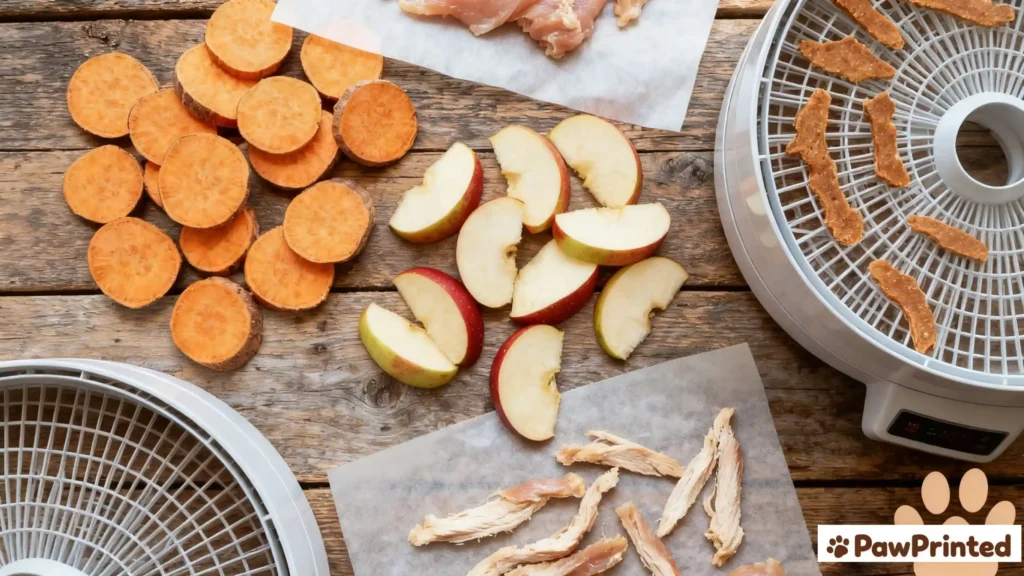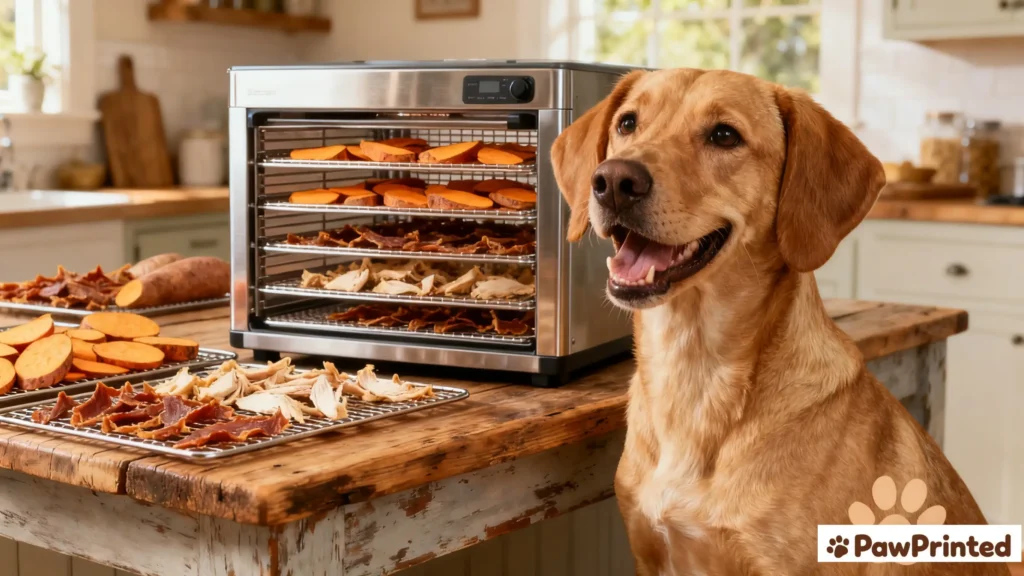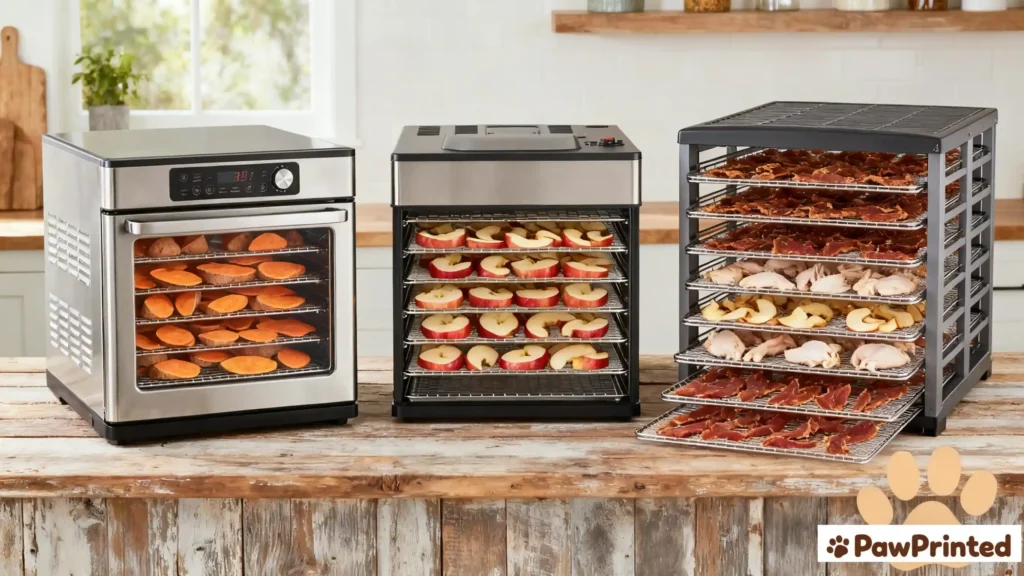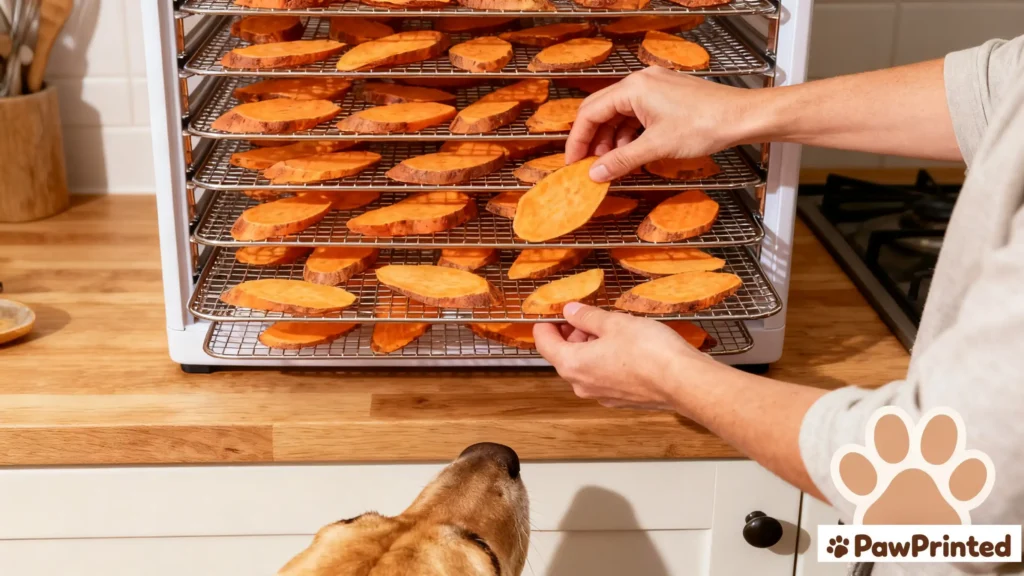We tested popular food dehydrators in real dog-treat scenarios to find models that dry evenly, run quietly, and clean up quickly. Compared with an oven, a good dehydrator holds lower, steadier heat with active airflow — fewer burnt edges, better texture, and more predictable batches.

Top Picks (2025)
Best Overall — COSORI Stainless Steel 6-Tray
- Wide temperature control ~95–165°F with digital timer
- Rear fan for even drying; consistent results across trays
- Stainless steel trays; straightforward, hygienic cleanup
- Best for: multi-dog households making jerky weekly
Best Budget — Nesco Snackmaster Pro FD-75A
- Proven classic; expandable tray system
- Adjustable temperature (upper limit ~160°F)
- Lightweight and easy to store; broad accessory ecosystem
- Best for: beginners and occasional small batches

Best Large Capacity — Magic Mill Digital 7-Tray
- Rear-fan horizontal airflow with glass door
- Programmable timer & auto shutoff; ~95–158°F range
- Fine mesh/nonstick liners included (kit dependent)
- Best for: big batches and parallel recipes

Best Compact — Presto Dehydro (06300)
- Small footprint; beginner-friendly, simple controls
- Fixed temperature (~165°F)
- Stackable trays; easy to stash in small kitchens
- Best for: first-time users and tiny kitchens
Best Quiet / Premium — Excalibur 9-Tray
- Rear fan with even airflow; long-time favorite for jerky
- Adjustable temperature ~95–165°F; huge tray area
- Strong community support and add-on accessories
- Best for: serious treat makers and micro-businesses

Comparison Table
| Model | Trays | Temp Range* | Airflow / Fan | Cleanup | Best For |
|---|---|---|---|---|---|
| COSORI 6-Tray | 6 | ~95–165°F | Rear fan (even) | Stainless trays | Overall |
| Nesco FD-75A | 5 (expandable) | Up to ~160°F | Top fan (swap trays mid-way) | Hand wash | Budget |
| Magic Mill 7-Tray | 7 | ~95–158°F | Rear fan (horizontal) | Dishwasher-safe racks (kit dependent) | Large Batches |
| Presto Dehydro (06300) | 4–8 (kit) | Fixed ~165°F | Bottom heat/fan | Hand wash | Compact |
| Excalibur 9-Tray | 9 | ~95–165°F | Rear fan (even) | Hand wash | Quiet / Premium |
*Temperature ranges are based on manufacturer specs; tolerances vary by batch. Always confirm on the product page.
How We Test (Real Treats, Repeatable Protocols)
We dry three treat types to mirror real use:
- Thin chicken jerky (3–4 mm) — target: snaps cleanly, no wet sheen.
- Sweet potato sticks (5–6 mm) — target: fully dry, not browned.
- Meat & veggie purée sticks (10–15 mm diameter) — target: center fully dry.
Scoring covers temperature accuracy/control, airflow evenness, cleanup, noise, capacity, energy draw, safety, and accessories (mesh liners, fruit leather sheets). We also verify poultry reaches a safe internal 165°F before storage.
Buying Guide: What Matters for Dog Treats
- Temperature & Control: Look for ~95–165°F with small increments and a long timer. Lower settings protect nutrients and help avoid edge-browning.
- Airflow Design: Rear-fan (horizontal flow) tends to dry more evenly across trays than top/bottom heat.
- Tray Material & Hygiene: Stainless steel is durable and easy to sanitize; BPA-free plastics are lighter and often cheaper. Fine mesh prevents small pieces from falling through.
- Cleanup: Dishwasher-safe trays/liners save time if you dry sticky purées.
- Noise & Size: Quieter machines are better for overnight runs; check footprint against your counter space.
- Safety: Overheat protection, stable door latch, and food-safe materials matter for frequent use.
Pro Tips & Common Mistakes
- Slice consistently: 3–4 mm for jerky; 5–6 mm for sweet potatoes.
- Vent moisture: Don’t overcrowd trays; swap/rotate only if your model has top or bottom heat.
- Dry completely: Sticks should snap; any rubbery center shortens shelf life.
- Cool before sealing: Trap warm moisture and you invite condensation and spoilage.
- Storage rule of thumb: Room temp 2–3 weeks (airtight + oxygen absorber), fridge 1 month, freezer 2–3 months.
Still Unsure? Pick by Scenario
- Weekly jerky maker, wants stainless & even drying: COSORI 6-Tray.
- Starter budget, small batches: Nesco FD-75A.
- Big family, batch everything at once: Magic Mill 7-Tray.
- Tiny kitchen, occasional use: Presto Dehydro (06300).
- Quiet, premium capacity and control: Excalibur 9-Tray.
FAQ
Yes. Set the lowest temp (170–190°F) and prop the door slightly to vent moisture. A dehydrator is typically quieter, more even, and more efficient for long runs.
Highly recommended for purée sticks and small pieces. Try fine mesh liners so nothing drops through.
Most jerky and dense treats do well around 150–160°F (check your model’s guidance). Always dry until the center is fully firm and snaps.
Generally 2–3 weeks in an airtight jar at room temp (with oxygen absorber), about 1 month in the refrigerator, and 2–3 months in the freezer. Dry fully and cool before sealing.
For puppies over ~6 months, small amounts are usually fine. Keep pieces thin and crisp, introduce slowly, and consult your vet for breed- or health-specific guidance.
Wrapping It Up
Choose the model that fits your space, noise tolerance, and cleanup style. If you’d rather not DIY every week, see our
gentle wet picks andsteady dry picks.
Follow PawPrinted On Pinterest
“Want more dog food recipes, grooming hacks, and health tips? Follow us on Pinterest and save your favorite ideas — we share fresh inspo every week!”.

